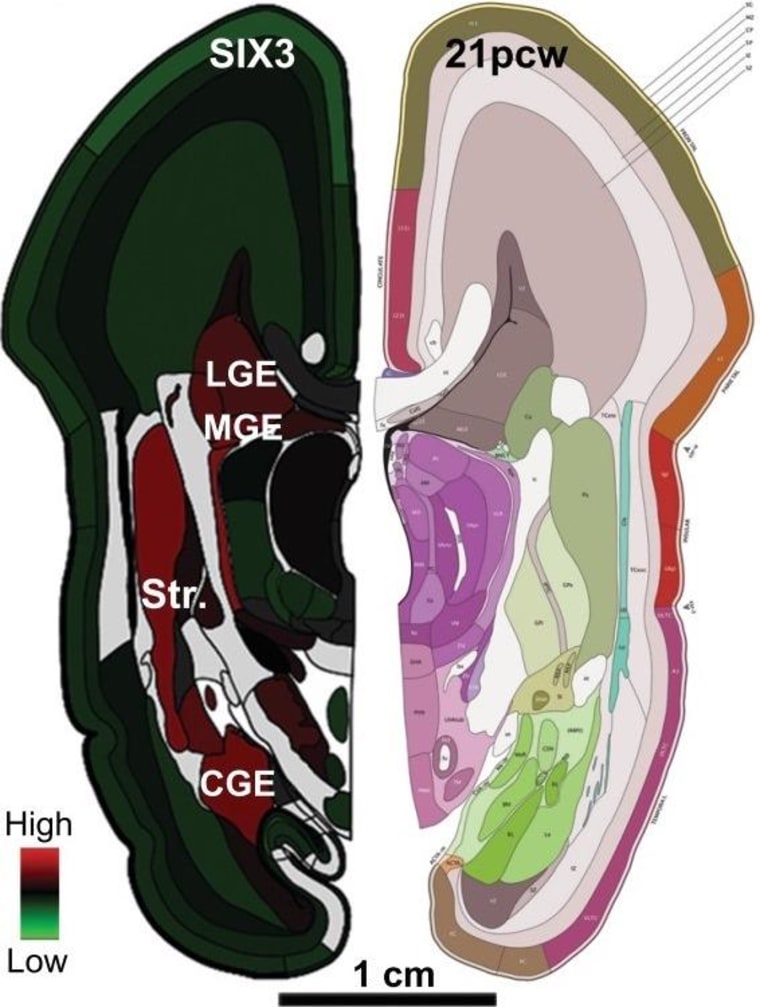A new kind of atlas reveals which genes control the development of which areas of the unborn human brain — and researchers are already studying the atlas' maps to gain new insights into neurological conditions such as autism.
"You can use this to understand the roots of developmental disorders," said Ed Lein, an investigator at the Seattle-based Allen Institute for Brain Science. Lein is the senior author of a report in the journal Nature about the $35 million brain-mapping project.
The BrainSpan Atlas of the Developing Human Brain is one of several projects to bear fruit in time for the first anniversary of the Obama administration's $100 million BRAIN Initiative. Also this week, a separate team of scientists shared the first map showing connections inside a mouse brain. Last week, yet another group released an atlas of the larval fly brain.
The genetic maps of the prenatal human brain are freely available online via the Allen Brain Atlas data portal.
"This atlas is already transforming the way scientists approach human brain development and neurological disorders like autism and schizophrenia," Thomas Insel, director of the National Institute of Mental Health, said in a news release. "Although the many genes associated with autism and schizophrenia don't show a clear relationship to each other in the adult brain, the BrainSpan Atlas reveals how these diverse genes are connected in the prenatal brain."
Insights into autism
Eventually, the BRAIN Initiative aims to create a variety of maps for the human brain at different stages of development, and the maps released this week represent a significant step in that direction. Researchers can use the BrainSpan atlas to hunt for correlations between gene expression and the development of specific regions of the brain — and also trace why things go wrong due to genetic factors.
"There are people who are working on many, many different things, and each person has their own special area of interest," said Charles Stevens, a neuroscientist at the Salk Institute for Biological Studies at La Jolla, Calif. "This is a resource for all of those people."
In the Nature paper, Lein and his colleagues report a significant overlap between a network of genes that play a role in generating excitatory neurons for the cortex, known as module C22, and sets of genes that have been implicated in autism. "This is additional evidence that the origins of autism may be prenatal," he told NBC News.
The findings are also in line with other research suggesting that early intervention can make a big difference for children with autism. "There's converging evidence on a place in space and time where we should be putting our focus," Lein said.
How the maps were made
Lein calls the atlas "a blueprint for human development." It was created by studying the brains of four human fetuses ranging in developmental age from 15 to 22 weeks after conception. The tissue samples were obtained from research repositories in Seattle and in Alameda, Calif.
Each brain was cut into slices. Then, each slice was scanned in microscopic detail to determine the location of functional areas. Genetic tests were also run for tens of thousands of areas in the brain samples. All those readings were cross-referenced in the atlas' computerized database.

The effort built on earlier projects that were conducted at the Allen Institute using mouse brains. "The work behind creating this atlas could not have been done anywhere else," Allan Jones, the institute's chief executive officer, said in a statement.
The potential applications go beyond medicine. Comparisons between humans and other species could reveal why we turned out to be so brainy. For example, Lein and his colleagues found a set of genes that were expressed strongly in the human frontal cortex and in a zone that serves as scaffolding for the early formation of brain circuitry.
"These features are all known to be expanded or show developmental differences in humans compared to other species," he said in this week's news release, "so our data gives unprecedented clues about the molecular underpinnings of what makes human neocortex unique."
Update for 12:30 p.m. ET April 4: Here's some further information to respond to the comments on this report. The fetal brain tissue for the atlas came from the Brain Defects Research Laboratory at the University of Washington and Advances Bioscience Resources in Alameda, Calif. Normal tissue with no known history of maternal drug or alcohol abuse, or HIV or hepatitis infection was eligible for inclusion in the study. However, because of confidentiality requirements, the researchers do not know whether the tissue came from aborted or miscarried fetuses.
Lein is one of 80 authors of the Nature paper, "Transcriptional Landscape of the Prenatal Human Brain." The project predates the BRAIN Initiative, and was supported with $35 million in federal stimulus funding from the National Institute of Mental Health.
